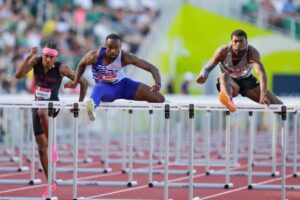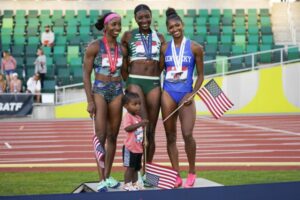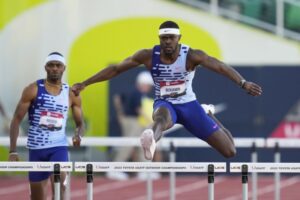A Look Back at USA’s
by Steve McGill
With another national championships in the books, it’s time to take a look back at what we saw in Eugene, Oregon last week and to take a look ahead at the World Championships that will take place in Budapest, Hungary in August. About the only good thing to come out of the pandemic is that it’s given us four years in a row of major championships — the Olympics in 2021, the WC’s in 2022 and 2023, and then another Olympic year coming up in 2024. Having a major championship every year adds excitement to the sport, and I hope that World Athletics decides to keep the WC’s going in all three years between the Olympic Games every fourth year into the future. But they probably won’t. And anyway, I digress. Let’s take a look at what went down in Eugene, with our focus of course being on the hurdling events.
[am4show not_have=’g5;’]
[/am4show][am4guest]
[/am4guest][am4show have=’g5;’]
One disappointing thing about the national championships has to do with the number of top-tier athletes who already have a bye to the World Championships, and therefore didn’t compete in their specialty event at nationals. Obviously, the rule that allows last year’s winners a bye is a reasonable and fair one, and also allows for a fourth athlete in those events to make the team, but it also serves to water down the quality of the competition at Nationals. For example, there was no Michael Norman in the 400, no Fred Kerley in the 100, and no Noah Lyles in the 200.
This scenario also affected the hurdling events, specifically the men’s 110’s with Grant Holloway, and the women’s 400’s with Sydney McLaughlin, although Sydney’s situation is different, as we’ll discuss later. For two rounds, Holloway was looking like that old-school athlete who doesn’t turn down a chance to compete. He looked very sharp in both the prelims and the semis. Meanwhile, DII champion Cordell Tinch was also looking sharp, as was Daniel Roberts and Freddie Crittenden. With Roberts being an old rival of Holloway’s going back to their college days, and with Tinch exploding onto the scene in recent weeks, the final was shaping up to be electrifying. But minutes before the final, as I was watching on TV, commentator Lewis Johnson came on the screen to inform the viewing audience that Holloway would not be competing. He explained that when he asked Holloway why, Holloway simply said, “I got a bye” and kept on walking.
The final was still hot, though, as Tinch (the only American to run under 13.00 this year) and Roberts battled it out for the national title. Roberts bolted out of the blocks, but Tinch caught him about midway through the race and maintained a slight lead heading into the last hurdle. Coming off the final hurdle, however, Roberts made a final push and timed his lean perfectly to eke out the victory. And it was great to see Crittenden’s joy after finishing third and finally making an international team. “Freddie! Freddie!” Roberts could be heard yelling after watching the video replay of the photo finish. It was really cool to see him more excited for his friend than for himself in this moment, as it serves as an example of the kind of sportsmanship I love to see.

Then there was my man Devon Allen, who has been trying to juggle two professional athletic careers at once, as he was on the Philadelphia Eagles’ practice squad last year and is determined to make the 53-man roster this year. With training camp coming up in August, he would’ve had a decision to make had he made the World Championship team. But he barely made the semis and then scratched out of the semis due to some hamstring soreness. On the TV broadcast, Ato Boldon said something about Allen not wanting to risk injuring the leg with training camp coming up. Well, everyone has to prioritize in life, and if making the 53-man roster matters that much to him, then I’m not gonna hate. But I can say, even as a lifelong Eagles fan, that I’d really rather see Allen running hurdles and building off that 12.84 he ran last year. His best chance of making the Eagles is as a punt returner, because even if they do end up needing more depth at wide receiver, they’ll probably trade for it or pick someone up off waivers instead of promoting him. But like I said, everybody’s gotta live their own life and I ain’t mad at him.
In the women’s 100 hurdles, the story was the return of Nia Ali. Bruh, I ain’t gonna lie, I thought she was retired. But now as a mother of three, she’s back to who she was in 2017. Of course, for me personally, her return meant a big “uh oh” through the rounds, as I have a rooting interest in Keni Harrison, having coached her in her formative hurdling years. Whenever Keni races, my objectivity goes out the window and I just want to see her win. This year, having switched coaches and having moved to Southern California to train with the legendary Bobby Kersee, she’s been consistently fast, having lost only once — to Jasmine Camacho-Quinn — heading into Nationals. In addition to Ali and Harrison, there were a whole lot of fast competitors in this event, as there always seems to be.
Among them were Alaysha Johnson, whose 12.37 in the finals ended up being tied for the fastest time of the meet. Then you had the college girls who have been bringing the smoke all year long — Masai Russell of Kentucky and Alia Armstrong of LSU. Add Tonea Marshall and Tia Jones to the mix, and you had a whole host of women capable of making the team.

In the final, Ali got out a little bit ahead of Harrison and maintained that small lead all the way to the finish line. Johnson, who looked like a favorite to make the team after the semis, ended up being eked out for third by Russell, as both were timed in 12.46. Johnson missed making the team by .002.
In the men’s 400 hurdles, there’s only one name that needs mentioning, and that is Rai Benjamin. He’s an absolute monster in this event. The only people in the history of the event who have run faster than his 46.62 in the final are himself, Karsten Warholm, and Alison Dos Santos. With Dos Santos being injured, the World Championships will once again be a showdown between Warholm and Benjamin. In the final at Nationals, Benjamin took thirteen strides between the hurdles the whole way. I could be mistaken, but I think that’s the first time he’s done that. It’s definitely true that he’s never done it before as fluidly and easily. And that was with no one within a second of him. Wouldn’t be surprised if both he and Warholm are both under 46.0 at Worlds. As mind-bending as Benjamin’s race was at Nationals, Warholm is the one who owns the fastest time of the year heading into Worlds. If both men stay healthy, that race is gonna be hot hot hot!

The women’s 400 hurdle race was very impressive, despite the absence of McLaughlin, who was busy dominating the open 400. Both Shamier Little and Dalilah Muhammad — veterans of the hurdle wars — looked really good and seem ready to peak at Worlds. Little had the stronger finish in this race, but it’ll be interesting to see if Muhammad can counter at Worlds. I was also very happy for Ana Cockrell, who also made the team and ran an outstanding race. People often ask me if I ever coached Cockrell, as she’s from North Carolina. The answer is no, I didn’t, but I did watch her beat girls that I did coach on plenty occasions.

As for Sydney, she and her coach, the aforementioned Bobby Kersee, have decided that she will compete only in the open 400 at Worlds, although she’ll most likely return to the hurdles next year. My thinking all along earlier this year was that she was running the open 400 in order to improve her flat speed for the hurdles, and that she’d return to the hurdles after Nationals. But I think she did so well in the open 400 at Nationals that it only made sense to go for gold in that event in August. The decision almost guarantees that Femke Bol will win the 400h at Worlds, as no one else in the world is anywhere near the times she is running. Because Bol is now 14-stepping a good portion of the race, I was really looking forward to a showdown between her and Sydney. But I guess it’ll have to wait a year.
[/am4show]
